Rifftides: May 2008 Archives
A Los Angeles man and wife, Doug McIntyre and Penny Peyser, last night premiered Trying To Get Good, a film about the trumpeter, singer and outrageous humorist
 Jack Sheldon. They and others know that Sheldon is one of the most gifted musicians alive. They hope that the film will help bring him general recognition that he has deserved since the early 1950s. From Gary Goldstein's story in yesterday's Los Angeles Times:
Jack Sheldon. They and others know that Sheldon is one of the most gifted musicians alive. They hope that the film will help bring him general recognition that he has deserved since the early 1950s. From Gary Goldstein's story in yesterday's Los Angeles Times:
The couple spent more than five of their nearly six wedded years cobbling together this labor of love about Jack Sheldon, the best jazz trumpeter you may have never heard of despite his ubiquitous, over half-century presence on the Los Angeles entertainment scene. One of the pair's wishes for the film is that it helps Sheldon, now 76, achieve a wider respect and fan base, particularly from those less-embracing East Coast jazz critics. "Maybe they'll drop their West Coast bias for five minutes and just listen to what Jack's playing,"
To read all of Goldstein's story and his sidebar review of the Sheldon film, click here. Let's hope that the film makes it to DVD soon.
Late last year, this Rifftides posting recalled the first time I heard Sheldon.
In emulation of Art Kane's photograph Harlem 1958, widely known as A Great Day in Harlem, Great Day photographs have been made in cities all across the United States. Here, by permission of the Art Kane Archive, is the original.
 © Art Kane Archive
© Art Kane Archive
Not all of the copycat shots involve jazz. Baseball and hip-hop have also got into the act. The latest jazz entry is Indianapolis, which has produced major musicians including J.J. Johnson, Freddie Hubbard, Slide Hampton, David Baker, Joe Hunt, David Young and the Montgomery brothers, Wes, Buddy and Monk. The Indianapolis shoot is set for this Sunday, June l. For details, go here.
For background on the original Great Day in Harlem photograph and interactive identification of the musicians in the shot, go to the art kane web site and click on Harlem 1958. See this piece from the Rifftides archive concerning the film about the 1958 photograph and the events surrounding it.
More than one hundred musicians have signed up for the Indianapolis photo shoot, luncheon and (of course) jam session. If you're going to be there on Sunday, have a great day.
Today is Dave McKenna's 78th Birthday. He plays the piano.
Happy Birthday.
The other night at The Seasons, I heard four nineteen-year-olds and was impressed. One of
 them, the alto saxophonist Logan Strosahl, has been intriguing me for a couple of years. The others, who comprise The Uptown Trio, were new to me except for the bassist, Jeff Picker, whom I had previously heard with Strosahl.
them, the alto saxophonist Logan Strosahl, has been intriguing me for a couple of years. The others, who comprise The Uptown Trio, were new to me except for the bassist, Jeff Picker, whom I had previously heard with Strosahl.
All are beneficiaries of extensive high school jazz education and winners of prizes for excellence, all freshmen at prominent institutions of learning. Strosahl, from Seattle, is wrapping up his first year at the New England Conservatory in Boston. Picker, from Portland Oregon, is at the Manhattan School of Music, along with drummer Jake Goldbas of Hartford, Connecticut. The pianist, Sam Reider is a San Franciscan who attends Columbia University in New York. Anyone keeping a future file would do well to add those names. If these players keep developing at their current pace and intensity, it is likely that we'll be hearing from them.
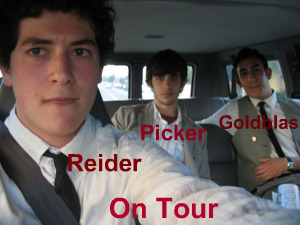
At The Seasons, they were equally adept in standard pieces and in--or on the border of--free playing. Strosahl has remarkable energy, technique and harmonic acuity. He tore up Dizzy Gillespie's "Anthropology." Following an ingenious Reider introduction, Strosahl electrified the house in his exploration of Matt Dennis's "Everything Happens To Me." In "The Disintegration," the Uptown Trio was impressive in its ability to achieve abstraction without sacrificing continuity and form, then Strosahl melded with them as the piece morphed into a blues for a powerful quartet effort that ended the concert.
I have been unable to locate an internet sample of Strosahl's playing, but on The Uptown Trio's MySpace page, there are four performances including "The Disintegration." Picker, Reider and Goldbas are businessmen as well as players, an essential attribute for survival in the twenty-first century jazz trade. On their own, they have lined up a month-long tour with appearances in major west coast jazz clubs including Yoshi's in San Francisco, Kuumbwa Jazz in Santa Cruz and Catalina in Los Angeles. The schedule is on their MySpace page.
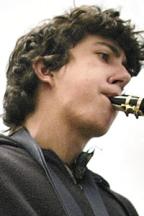 Another name for that future file: Nick Sokol, a young tenor saxophonist whose band has the unusual instrumentation of tenor and alto saxes, piano and drums; no bass. Sokol opened for Strosahl and the Uptowners with a four-part suite that ranged from lacy, vaguely Oriental, impressionism through free four-way improvisation to Brahmsian gravity. The piece had style and texture. I'd like to hear it again.
Another name for that future file: Nick Sokol, a young tenor saxophonist whose band has the unusual instrumentation of tenor and alto saxes, piano and drums; no bass. Sokol opened for Strosahl and the Uptowners with a four-part suite that ranged from lacy, vaguely Oriental, impressionism through free four-way improvisation to Brahmsian gravity. The piece had style and texture. I'd like to hear it again.
From 1949 to 1963, the Black Hawk was San Francisco's premier jazz club. It presented a
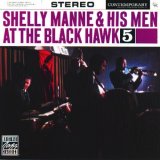 cross section of the world's best musicians. Like legions of other fans, I spent some of the most rewarding listening hours of my life being inspired in the Black Hawk's uninspiring surroundings and have written about it frequently. Here are the opening paragraphs of the notes for volume 5 of Shelly Manne and His Men At The Blackhawk.
cross section of the world's best musicians. Like legions of other fans, I spent some of the most rewarding listening hours of my life being inspired in the Black Hawk's uninspiring surroundings and have written about it frequently. Here are the opening paragraphs of the notes for volume 5 of Shelly Manne and His Men At The Blackhawk.
During my years of labor at KGO-TV in San Francisco, I never passed the parking lot a block away at Turk and Hyde without regretting the injustice of a world that puts more value on the storage of automobiles than on preserving historical landmarks. To be accurate the Landmark Preservation Commission never actually got around to trying to save the Black Hawk or even mounting a brass plaque at space number five, the approximate location of the door where Elynore Caccienti and Susan Weiss collected one-dollar entry fees and dispensed wisdom. All right: the matter never came to a vote, never even came up for discussion.
Nonetheless, officially recognized or not, history was made in the dust and dimness of that temple of gloom. "I've worked and slaved to keep this place a sewer," Guido Caccienti used to say of the joint he ran with his partner, George Weiss. In the 1950s when the club was in its florescence, Count Basie set a new world record for compacting musicians by cramming sixteen men onto the Black Hawk's little stand, adding Joe Williams, and still finding room to swing. Cal Tjader's and Dave Brubeck's groups were more or less headquartered at the Black Hawk and did some of their best live recording there. The first ten-inch LP by the Gerry Mulligan Quartet was made in September, 1952, while Mulligan, Chet Baker, Carson Smith and Chico Hamilton were at the Black Hawk refining their alchemy. The Miles Davis Quintet with Hank Mobley recorded two albums there, commemorating that regrettably short partnership. Although he recorded it in a hall a few blocks away, it was during a Black Hawk engagement that Thelonious Monk made a solo piano album notable for the beauty and serenity of his playing.
I bring this up because video has materialized that reveals the interior of the Black Hawk in all its--er--glory. The film was made for the pilot of a TV series that never materialized. It features the Brubeck Quartet in three numbers, with an introduction by Mort Sahl, the comic who was a fan of the band and a close friend of Paul Desmond until Mrs. Sahl and Desmond became even closer. That, of course, is another story, discreetly told in Take Five: The Public and Private Lives of Paul Desmond. But, in a cheesy effort to sell a book, I digress. At any rate, the video is slightly misleading about the nature of the club because the producers somehow persuaded Guido that it was necessary to present an orderly aspect. The random distribution of miniscule tables gave way to chairs arranged in rows, as in a concert hall. The chairs are occupied not by casually dressed and relaxed Black Hawk regulars but by properly attired civilians, possibly extras hired for the occasion. Nothing was done, thank goodness, to replace the dust-laden heavy velvet curtain behind the band stand.
The band is the classic Brubeck Quartet with Desmond, Gene Wright and Joe Morello. YouTube doesn't give us a date, but the repertoire and the appearances of the players suggest 1957 or '58. The band opens with "The Duke" as background for Sahl's intro and follows with a splendid "St. Louis Blues" and a perfunctory "I'm In A Dancing Mood." During the blues we have the opportunity to see as well as hear the camaraderie between Wright and Morello. To see the video, click here.
Four years ago, another club went up at the corner of Turk and Hyde. Here's a description from its web site:
222 Club was established in April 2004. It sits on a corner next to a parking lot and lots of action. We are a lounge with a beautiful basement, refreshing cocktails, delicious food, rotating dj's, live bands and rotating art. Happy Hour Tuesday thru Saturday from 6-9pm $3.00 Well $2.00 PBR Positive Vibes Only~ We are happy people.....xoxoxoxoxThe hugs and kisses are a nice touch, but I'll bet the 222 Club isn't hiring the Basie band.
Early in his career, pianist Billy Taylor made a difference in jazz by developing an individual
 approach to the use of chords. His concept fit well with that of the beboppers who in the second half of the 1940s were a new and powerful force in the music. Some swing musicians with open ears and open minds--notably Ben Webster--were also intrigued by Taylor's full-bodied harmonic notions.
approach to the use of chords. His concept fit well with that of the beboppers who in the second half of the 1940s were a new and powerful force in the music. Some swing musicians with open ears and open minds--notably Ben Webster--were also intrigued by Taylor's full-bodied harmonic notions.
Taylor arrived in New York in 1942, fresh out of college, a devotee of Art Tatum. In 1944, he went to work for Webster, the great Duke Ellington tenor saxophonist. In 1949 and 1950, he was the house pianist at Birdland backing a variety of musicians, among them Charlie Parker, Dizzy Gillespie, Lester Young, Stan Getz and Milt Jackson. By 1951, his ideas and popularity had blossomed to the point where he graduated from sideman to leader of his own trio. Previously unreleased music by that group has shown up on Taylor's web site. I'm going to give you a link to it, but those unfamiliar with how Taylor developed may be interested in a bit of background. Here is some of what I wrote in the booklet for the CD reissue of Billy Taylor Trio, a collection of pieces he recorded in 1952 and 1953.
Webster encouraged Taylor's use of rich chords in accompaniment. Taylor was inspired harmonically by Duke Ellington's piano introduction to "In a Mellotone," which he heard when he was a student. "That wiped me out," Billy says. "I said, 'what's he doing? So I figured it out. It was A-flat ninth in the left hand and an octave with a fifth, A-flat, E-flat and A-flat, in the right hand. I liked it and began fooling around with it, added a couple of things to it: one voicing in one hand and another voicing in the other.
"When I came to New York, that was a part of my approach. Most horn players said, 'That's in my way,' because they were used to being accompanied around middle C, in the lower part of the piano. I was an octave higher. Ben was a former pianist. He liked it and encouraged me to do it." Over the next decade, Taylor refined his chord-plus-octave style.
By the time he had realized his ambition to form a permanent trio and went into the Prestige studio in late 1952, the sophisticated technique was in his musical grain. By then, a Taylor harmonic invention might be built like this: B-flat, C-ninth, E and G or G-13th in the left hand, C, E, G and C in the right hand. "I was harmonically oriented," he says, a masterpiece of understatement. "In those days a lot of these harmonies were not common. I was very proud that I was able to establish then."
For a 1951 Taylor engagement at George Wein's Storyville club in Boston, Taylor worked with
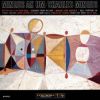 bassist Charles Mingus and drummer Marcus Foster. The music that surfaced recently was broadcast on a radio program hosted by another young man destined to become a jazz institution, the critic Nat Hentoff. To hear several pieces by the trio and Hentoff's carefully scripted comments, go here, scroll to the bottom of the page and click on the start button on the video screen. I recommend at least one listening in which you concentrate on Mingus's compelling bass lines. At the end of the Taylor trio performance, you'll see a short biography that incorporates an interview by Ed Bradley of CBS's 60 Minutes.
bassist Charles Mingus and drummer Marcus Foster. The music that surfaced recently was broadcast on a radio program hosted by another young man destined to become a jazz institution, the critic Nat Hentoff. To hear several pieces by the trio and Hentoff's carefully scripted comments, go here, scroll to the bottom of the page and click on the start button on the video screen. I recommend at least one listening in which you concentrate on Mingus's compelling bass lines. At the end of the Taylor trio performance, you'll see a short biography that incorporates an interview by Ed Bradley of CBS's 60 Minutes.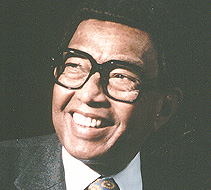
Taylor will be eighty-seven years old in July. He was scheduled to be at Teachers College, Columbia University, New York, this week to perform and to discuss his life, music and career, but the event has been postponed. For details, go here.
I think one of the best things you can do, no matter what you play, is to take up piano. Music is based on chord changes and harmonies, and you can get 'em more out of an instrument like piano, where you can hear all the notes at once. --Zoot Sims
To me, the piano in itself is an orchestra. --Cecil Taylor
I believe in using the entire piano as a single instrument capable of expressing every possible musical idea. --Oscar Peterson
When you look at the keyboard, all the notes are there already. But if you mean a note enough, it will sound different. You got to pick the notes you really mean. --Thelonious Monk
 Tenor saxophonist Johnny Griffin recently entered his eighty-first year, still living and playing at full--or nearly full--speed. Martin Gayford today observed Griffin's longevity and vigor in a piece in the British newspaper the Telegraph. Here's an excerpt:
Tenor saxophonist Johnny Griffin recently entered his eighty-first year, still living and playing at full--or nearly full--speed. Martin Gayford today observed Griffin's longevity and vigor in a piece in the British newspaper the Telegraph. Here's an excerpt:
To read all of Gayford's article, go here. Griffin mentions to Gayford the importance in his early New York days of being around three pianists, Bud Powell, Thelonious Monk and Elmo Hope. When I interviewed him for JazzTimes in 1995, he expanded on his experience with them in what he called "my conservatory of music."
He was described by Richard Cook in his Jazz Encyclopaedia as "the fastest tenorman of them all". He has slowed down a little, but not that much. "I got so excited when I played and I still do," he has said. "I want to eat up the music like a child eating candy."
There was always, however, more to Griffin's style than simply speed. Whatever you are playing, he once advised a fellow musician, you should always play the blues - meaning, always play with feeling. He has a richness of sound that is characteristic of the great jazz tenor saxophone tradition.
Griffin still lives in the French countryside near Vienne in south central France. His 198-year-old stone house is called Chateau Bellevue, "beautiful view." Here's a bit more from the JazzTimes piece.
"These guys were like triplets," Griffin says. "They loved each other and they were always at one another's houses. So much respect. So much music. For some strange reason, they adopted me, and that's how I got my education. For instance, we'd all go to Monk's when he was rehearsing his band with Ernie Henry and the cats from Brooklyn. I heard so much music, it stayed with me forever. They didn't give me any instruction, they just played.
"I'd hear something Monk played on, say, 'Coming On The Hudson,' and I'd say, 'Wait a minute, hold it, T. What is that?' And he'd say, 'Oh, that's a D-something cluster. But it's only relative. Everything is relative.' Later on, I realized what that meant. The chord is literal, but it's also something that you live. Music can be mathematics, but it's also the relationship between things. It's life."
Inside, through the blue-gray of darkening air the tenor saxophonist is gazing toward the village across the Vienne River, three quarters of a mile down the hill. Behind the town is the rising bul of the Massif Central. A center of the ceramics industry, this are of dry hills is also know for its livestock. One of the walls of Griffin's courtyard is the back of a neighbor's cattle barn.
To reach gigs, Griffin drives an hour to the train station at Angoulème, Limoges or Poitiers, takes a high-speed train 150 miles northeast to Paris and flies from Orly airport to Los Angeles, Tokyo, Chicago, New York, Paris or wherever there is a demand for world-class tenor playing.
The June, 1995, article is not archived on the JazzTimes web site. Your library may have it. If you are unfamiliar with Griffin, I suggest not wasting a moment to seek him out. For a starter CD, you could do little better than this 1957 album with Sonny Clark, piano; Paul Chambers, bass; and Kenny Dennis, drums.
For a video sample of Griffin at work with Gérard Badini's big band, click here. YouTube has several other clips of Griffin playing in a variety of settings.
George Moore, who runs Dave Brubeck's office, sent this message:
If you are suffering from bruised or broken ribs, PLEASE WAIT TO OPEN THIS LINK.
Then, rummaging around on the internet, I found this companion piece of video.
Now, no matter what kind of day you were having, you'll have a better one.
I'm not sure why it took me so long to find out about the Industrial Jazz Group, but life is full of unintentionally delayed gratification. I'm also not sure why it took me so long to come across Amedei chocolate, Norma Winstone, the writing of James Salter or the psychic rewards of gardening.
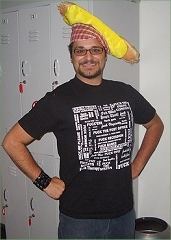 In any case, Andrew Durkin--the Industrial Jazz Group's leader, pianist and composer-- intrigued me with an e-mail message asking if I would be willing to hear a CD by his band. So that the disc would not disappear into an impenetrable landscape of stacks of unbidden review copies, never to be seen again, I asked him to send it with a note reminding me to listen right away. What turns out to be the fifth CD by this whimsical, musical, fifteen-piece band showed up with the reminder. I listened right away, give or take a few days. Within moments, I was grinning, then laughing, then shaking my head at the complexity of the music and the skill with which the IJG performed it.
In any case, Andrew Durkin--the Industrial Jazz Group's leader, pianist and composer-- intrigued me with an e-mail message asking if I would be willing to hear a CD by his band. So that the disc would not disappear into an impenetrable landscape of stacks of unbidden review copies, never to be seen again, I asked him to send it with a note reminding me to listen right away. What turns out to be the fifth CD by this whimsical, musical, fifteen-piece band showed up with the reminder. I listened right away, give or take a few days. Within moments, I was grinning, then laughing, then shaking my head at the complexity of the music and the skill with which the IJG performed it.
The humor is both subtle and slapstick, the musicianship consistently impressive. The band's comprehensive web site reflects the wackiness of the music but also practices modern marketing by linking to a company store offering T-shirts, mugs, a mouse pad, a thong and a one-piece baby garment. Maybe that's the industrial aspect of the band.
On the site, Durkin writes that he doesn't see the value of lists of influences but admits to being under the sway of Frank Zappa, Duke Ellington and Charles Mingus. Unopposed to lists, I will point out that he might also have mentioned Stravinsky, Archie Shepp, Spike Jones, Carla Bley, Raymond Scott, Satie, the AACM, Charles Ives and the Marx Brothers. The CD that arrived is called -- don't ask me why -- LEEF. According to the nearly unreadable
 information on the CD envelope (cleverly printed in white on yellow) it was recorded "mostly live" in concert in Amsterdam. The singer, Jill Knapp, is excellent. I presume that it is she whom we see cavorting in the promotional video to which you will find a link on this page.
information on the CD envelope (cleverly printed in white on yellow) it was recorded "mostly live" in concert in Amsterdam. The singer, Jill Knapp, is excellent. I presume that it is she whom we see cavorting in the promotional video to which you will find a link on this page.
Fair warning: a couple of the tracks have language that is less shockingly foul than boringly and repetitively foul. It gives the kids a chance to talk dirty in public and doesn't last long. (Perhaps I should have mentioned Lennie Bruce in that list of possible influences.)
But it's the music that matters most. The music is good.
Bob Florence was best known for his big band arranging, as his Grammy award, thirteen Grammy nominations and two Emmys attest. He died last Thursday at home in Thousand Oaks, California, five days short of his 76th birthday. Florence was also a superb pianist and favorite
 accompanist of singers. In recent years, in a pan-generational surprise, he hit it off with the adventurous young trumpeter Ingrid Jensen. Florence and Jensen discovered an affinity in a jazz festival after-hours session and, after that, played whenever they could manage to get together. Unfortunately, they seem not to have recorded.
accompanist of singers. In recent years, in a pan-generational surprise, he hit it off with the adventurous young trumpeter Ingrid Jensen. Florence and Jensen discovered an affinity in a jazz festival after-hours session and, after that, played whenever they could manage to get together. Unfortunately, they seem not to have recorded.
Of the many albums Florence made with his Limited Edition big band, I find myself going back most often to the one called Serendipity. His empathy and supportiveness as an accompanist are evident in Flight of Fancy, a CD of Alan and Marilyn Bergman songs that he shared with the singer Sue Raney. As a solo pianist, Florence offered a sensitive touch and an arranger's sense of harmony and placement of chords. His CD Another Side is evidence. Florence was natural, easy-going and inspirational as a music educator. He went out of his way to help school children learn what jazz is made of. The All About Jazz web site, has an excellent, uncredited, appreciation of Florence. There is an extensive obituary in his hometown paper, The Ventura County Star.
Rifftides reader John Altman writes from London:
Got an email from the British Film Academy (BAFTA) offering AN EVENING OF CHARLIE PARKER. At last, I thought, the elusive video from Canadian TV with Brew Moore and Paul Bley I've been hearing about for years. Opened the email and it was publicising AN EVENING OF CHARITY POKER! Oh well, guess I need new glasses after all!! Proves that the eye sees exactly what it wants to see.
Many of the same letters. So close
Correspondent John Birchard patrols the jazz precincts of the US capital city for Rifftides.
13th Annual Women In Jazz Festival
Kennedy Center, Washington, DC
Second Night
May 16, 2008
Review by John Birchard
Pianist Helen Sung, who won last year's Kennedy Center Mary Lou Williams Women in Jazz competition, led off the Friday night event. Heading a quartet that included saxophonist Steve Wilson, bassist Richie Goods and drummer Donald Edwards, Sung
presented a package of three compositions by Thelonious Monk, intriguingly re-arranged. She took the third piece, "Bright Mississippi", at a blistering tempo that showed off the leader's impressive keyboard technique.
A pair of originals completed Sung's program. Sung began her "Shall We Tango" with an out-of-tempo introduction that emphasized the seductive tango rhythm but in an impressionistic way. Steve Wilson was effective in his solo, as was bassist Goods. An attractive composition called "Songbird" was the set closer, incorporating Latin rhythm with more of Sung's engaging style at the keyboard.
Next up was the singer Sheila Jordan, who was presented the 2008 Mary Lou Williams Women in Jazz Award for her contributions to the music over the years. She joins such other artists as Jane Iran Bloom, the late Patti Bown, Toshiko Akiyoshi, Marian McPartland and Melba Liston as winners of the award. Jordan described herself as "seventy-nine-and-a-half" years old, but "feeling fourteen."
Jordan eased into "Lucky to Be Me" by improvising on the lyric to thank the Kennedy Center and Billy Taylor, artistic director for jazz at the Center, for honoring her. Her
intonation is a little shaky these days, but she overcomes it by hitting the notes she's capable of and half-talking the rest. She was joined on stage by a stellar trio - Steve Kuhn on piano, David Finck on bass and the drummer Billy Drummond, a group certainly capable of carrying a set by themselves. Jordan was engaging and funny in her between-songs commentary, a sort of stream-of-consciousness series of ad libs that delighted the Terrace Theater audience. Following the Ivan Lins melody, "The Promise of You", Jordan had fun with Bobby Timmons' "Dat Dere". Her tribute to Miles Davis began with her own seemingly improvised lyric about Miles' ballad playing and segued into "It Never Entered My Mind".
Jordan then introduced from the audience her former student Theo Blackman, who joined her on stage to sing "Every Time We Say Good-bye", which Jordan followed with a slow, heart-felt reading of "For All We Know". The two embraced and exchanged kisses, their obvious rapport with each other generating a warm bath of applause.
Jordan closed her set with a blues that featured more apparently spontaneous lyrics including thanks to her accompanists, the Kennedy Center, her late friend Shirley Horn--a Washington native--and the audience for supporting live music. What Sheila Jordan may have lost over the years in vocal equipment, she has more than made up for in stage presence and infectious personality. It was good to be reminded of those who labor in the shadows of little recognition, but who deserve far greater appreciation. Sheila Jordan is surely one of them.
Topping off the evening was drummer Sherry Maricle and her all-woman quintet Five Play. When I first heard Maricle, perhaps fifteen years ago, her playing reminded me of Mel Lewis. Nowadays, if I had to suggest a drummer after whom she has patterned herself, it would be Buddy Rich. Maricle
is all about hard-driving energy and technique. Her band lit into a Horace Silver-sounding original to kick off the set. The tune showed the group's strengths: tight, well-rehearsed ensembles, strong solos by the side persons and a kicking Maricle tying the chart together.
Five Play includes Janelle Reichman on tenor sax and clarinet. Reichman has a sound somewhat similar to Zoot Sims and abundant chops to handle fast tempos that reminded this listener of Sal Nistico. The trumpeter Jamie Dauber produced a bright, brassy sound and a plunger technique that would qualify her as a prime candidate for the Ellington band. Tomoko Ohno holds down the piano bench with strong chops and a two-handed solo style that emphasizes the bluesy aspects of a tune. The bassist Noriko Ueda plays firm time and her solos showed imagination and technique. An additional member of the cast is the Portuguese-born singer Marie Amadon, who impressed with her readings of "Old Devil Moon" and "Comes Love."
Departing from her mostly up tempo choices, Maricle introduced a walking "Cry Me a River" that featured Janelle Reichman on clarinet. Reichman's tone on the instrument is liquid and mellow, somewhat akin to that of Eddie Daniels, which is meant as a compliment. The evening came to a climax with a speed reading of the feminist anthem made famous by Helen Reddy, "I am Woman (Hear me Roar)", taken at a tempo designed to separate the women from the girls. Everyone offered heated solos and Sherry Maricle rounded out the performance with a high-energy solo. The term "flag waver" came to mind as she had the audience on their feet - and not just to hustle to the exits.
Rifftides Washington, DC correspondent John Birchard is attending one of the city's major music festivals. Here is his report on the first night.
13th ANNUAL THE KENNEDY CENTER MARY LOU WILLIAMS WOMEN IN JAZZ FESTIVAL
May 15, 2008
Review by John Birchard
They tried to find a longer name for the festival. The above is the best they could come up with. But that's the Kennedy Center... big, bulky and institutional. Still, once you get inside that huge marble box, some nice things take place, like Women in Jazz.
This year's fest began with Grace Kelly. Not the Princess of Monaco, of course, but the
ridiculously talented young saxophonist from Boston. Kelly, an Asian American celebrating her 16th birthday (yes!), led a quintet made up of drummer Terri Lynne Carrington, another woman who made her mark early; pianist Doug Johnson, bassist Evan Gregor; and trumpeter Jason Palmer.
Kelly led her band through a program of mostly originals, demonstrating her rapidly maturing style on alto and a penchant for latin rhythms and sophisticated melodies that incorporate interesting twists and turns. She played curved soprano on one number, showing off a rounded, pleasing tone. The only two standards in the program were a fresh approach to Gershwin's "Summertime" and a lovely reading of Monk's "Round Midnight" in which she played alto accompanied only by bassist Gregor. All of her bandmates performed well, especially Palmer, whose taste and imagination kept his impressive chops under control in the service of the music. It was a thoroughly satisfying set.
Before last night, I had never heard of the singer Catherine Russell. It's my loss. She is the daughter of the late Luis Russell, who served as Louis Armstrong's band director back in the 30s, and the bassist/singer Carline Ray. Catherine is a wonderful, strong singer with
a particular interest in old-timey songs like "My Man's an Undertaker (He's Got a Coffin Just Your Size"), "The Joint is Jumpin'" and Hoagy Carmichael's "New Orleans".
She was accompanied by a fine trio of swing-oriented musicians - pianist Mark Shane, guitarist Matt Munisteri who contributed several tasty and soulful solos, and bassist Lee Hudson. Russell's repertoire is choice, from "I'm Lazy That's All" associated with Pearl Bailey to "I'm Just a Sucker for a Broken Nose" and her own original "Lucy", about various addictions. Her set was full of delightful surprises and when she closed out roaring with "Kitchen Man", she had earned the cheers of the capacity crowd.
Rounding out the evening was the Japanese pianist Keiko Matsui, whose music is a far piece from Catherine Russell's. It's a combination of electric instruments (keyboards, bass, guitar), heavy percussion (a two-man battery), and a mix of Latin rhythms and New Age harmonies. The program was built completely on Ms Matsui's original compositions, which this listener found to be repetitive, but which the audience applauded enthusiastically.
Her band was tight and expert in the repertoire. Steve Reid was especially effective surrounded by a collection of percussion items all of which he used. Keiko Matsui has abundant technique and is attractive and personable. I was bored by the performance, but the audience ate it up, so who's wrong here?
I took a break from writing this morning and went for a ride with my friend Bianchi Vigorelli (pictured).
 Here in the lee of the Cascades, it was the first truly hot day of the year. Melted snow is rushing off the mountains, filling the rivers to the tops of their banks, running them fast and muddy, carrying along the occasional downed tree and drowned animal. The Yakima and the Naches are not at official flood stage, but they're getting close. If I lived in one of the low-lying areas nearby, I'd be making evacuation plans.
Here in the lee of the Cascades, it was the first truly hot day of the year. Melted snow is rushing off the mountains, filling the rivers to the tops of their banks, running them fast and muddy, carrying along the occasional downed tree and drowned animal. The Yakima and the Naches are not at official flood stage, but they're getting close. If I lived in one of the low-lying areas nearby, I'd be making evacuation plans.
Along the river banks, in the parks and through the towns, dogwoods, magnolias, apple trees and profusions of flowers are in full bloom. Large numbers of redwing blackbirds and cedar waxwings (pictured)
 have materialized -- and platoons of people in shorts and tank tops. For the most part, I found it more edifying to watch the birds. The ride--a twenty-miler--was a warmup for a longer round trip on Sunday through the Yakima River Canyon, which will be free of motorized traffic that day. A few of the hills are long and challenging enough to be character builders, but for the most part it's a leisurely cruise with a few hundred cyclists of all ages. Great fun. I wish that you could join us.
have materialized -- and platoons of people in shorts and tank tops. For the most part, I found it more edifying to watch the birds. The ride--a twenty-miler--was a warmup for a longer round trip on Sunday through the Yakima River Canyon, which will be free of motorized traffic that day. A few of the hills are long and challenging enough to be character builders, but for the most part it's a leisurely cruise with a few hundred cyclists of all ages. Great fun. I wish that you could join us.
Have a good weekend.
 After David Remnick took command as editor of The New Yorker in 1998, he curtailed the late Whitney Balliett's contributions to the magazine, relegated him to writing about celebrities like Barbra Streisand and eventually dropped the pre-eminent jazz writer altogether. Characteristically, Balliett kept quiet about the slight, but he was hurt and humiliated. In their fury, some of his devoted readers unsubscribed and never forgave Remnick. The editor himself is a gifted writer. The Balliettomanes may be somewhat mollified by Remnick's piece about a voluble eccentric dedicated to making people understand and appreciate jazz. The first sentence of Remnick's profile of Phil Schaap in the May 19th issue of The New Yorker is almost as long as a Charlie Parker solo and perfectly captures Schaap's magnificent fixation.
After David Remnick took command as editor of The New Yorker in 1998, he curtailed the late Whitney Balliett's contributions to the magazine, relegated him to writing about celebrities like Barbra Streisand and eventually dropped the pre-eminent jazz writer altogether. Characteristically, Balliett kept quiet about the slight, but he was hurt and humiliated. In their fury, some of his devoted readers unsubscribed and never forgave Remnick. The editor himself is a gifted writer. The Balliettomanes may be somewhat mollified by Remnick's piece about a voluble eccentric dedicated to making people understand and appreciate jazz. The first sentence of Remnick's profile of Phil Schaap in the May 19th issue of The New Yorker is almost as long as a Charlie Parker solo and perfectly captures Schaap's magnificent fixation.
Every weekday for the past twenty-seven years, a long-in-the-tooth history major named
Phil Schaap has hosted a morning program on WKCR, Columbia University's radio station, called "Bird Flight," which places a degree of attention on the music of the bebop saxophonist Charlie Parker that is so obsessive, so ardent and detailed, that Schaap frequently sounds like a mad Talmudic scholar who has decided that the laws of humankind reside not in the ancient Babylonian tractates but in alternate takes of "Moose the Mooche" and "Swedish Schnapps."
The article illuminates Schaap's obsessive-compulsive persona, his exhaustive--and exhausting--knowledge of jazz, and the status of the music American culture owes so much and appreciates so little. To read Remnick's profile of Schaap, go here. At the bottom of the online pages is an audio player, giving you the opportunity to listen to Schaap ruminating his way through a substantial portion of one of his broadcasts.
(Chet) was so sweet when he played, so mysterious. Somehow he was able to express the question mark of life with so few notes. In Italy, we're more sentimental, and we felt that very much. --Enrico Pieranunzi
Well, if I could play like Wynton (Marsalis), I wouldn't play like Wynton --Chet Baker
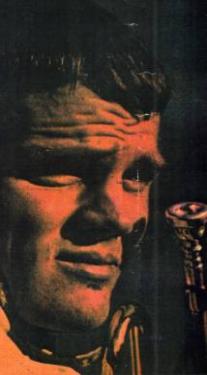 Chet Baker's life of beauty and pain ended twenty years ago tonight on an Amsterdam sidewalk. He may have killed himself. That is unlikely, in my opinion. He may have fallen from his hotel window. He may have been thrown or pushed. Either way, as hard as Baker was on nearly everyone else in his life, he was even harder on himself. Far from the first gifted artist to burn himself out, Chet did it rather slowly compared with Charlie Parker, Bix Beiderbecke, Oscar Wilde and Edgar Allan Poe. It is a tribute to the toughness of his Oklahoma country genes that despite decades of self-abuse, he lived nearly fifty-eight years.
Chet Baker's life of beauty and pain ended twenty years ago tonight on an Amsterdam sidewalk. He may have killed himself. That is unlikely, in my opinion. He may have fallen from his hotel window. He may have been thrown or pushed. Either way, as hard as Baker was on nearly everyone else in his life, he was even harder on himself. Far from the first gifted artist to burn himself out, Chet did it rather slowly compared with Charlie Parker, Bix Beiderbecke, Oscar Wilde and Edgar Allan Poe. It is a tribute to the toughness of his Oklahoma country genes that despite decades of self-abuse, he lived nearly fifty-eight years.
Jazz is an art most of which disappears at the instant of its creation. We can be perversely grateful that Baker supported his destructive habit by recording whenever anyone asked him to. There may be a major jazz artist with a larger body of recorded work, but I can't think who it might be. An astonishing percentage of it is good. He did some of his best playing on record in his final years, when the conventional wisdom was that he was a creative shadow of his young self. He made the brilliant Chet Baker in Tokyo in concert less than a year before he died. It includes the ultimate version of his signature piece, "My Funny Valentine."
Because YouTube has withdrawn most of its clips of Baker under threat of legal action, there is little internet video of him. This brief clip from a performance of "Nardis" is an exception. This web site is a grab bag of things Baker and has links to several clips, including scenes from his dreadful 1950s movie Hell's Horizons. Be patient; the site has maddening buffering problems as the clips come up. This Jazz Icons DVD is the best bet for extended exposure to Baker playing on camera.
The best biography of Baker is probably yet to come because Jeroen de Valk is revising his substantial 1989 account of the trumpeter's life. Those who think that Baker was trashed in James Gavin's hateful Deep In A Dream: The Long Night of Chet Baker are looking forward to a more balanced treatment in de Valk's new edition.
The Chet Baker Foundation's web site contains a touching remembrance of Baker by his former drummer and loyal friend Artt Frank, who is at work on his own book about Baker. Its background music is a wonderfully intimate version of Chet playing "My Funny Valentine."
If I had the speed and fluidity of, say, Terry Teachout, I might have finished a spate of non-Rifftides writing assignments sooner--and a book or two on the side. As it is, there's a good chance that I'll return to blogging this very week.
Learn to write well, or not to write at all.--John Dryden, Essay on Satire
Coleridge was a drug addict. Poe was an alcoholic. Marlowe was killed by a man whom he was treacherously trying to stab. Pope took money to keep a woman's name out of a satire then wrote a piece so that she could still be recognized anyhow. Chatterton killed himself. Byron was accused of incest. Do you still want to a writer - and if so, why?--Bennett Cerf
A writer is a person for whom writing is more difficult than it is for other people.--Thomas Mann
Nine years ago, the clarinetist, improvisational whistler and musical educator Brad Terry hosted in the United States three young musicians he had worked with in Poland. I mean young.
Mateusz Kolakowski, the pianist, was thirteen. In this picture from that period, we see him with Terry. Bassist Michal Baranski and drummer Tomek Torres were fifteen. Terry toured the country with them in his old Dodge van, overnighting in RV parks and driveways and playing whenever they could, sometimes in paying gigs. They even stopped in Montana and jammed with Buddy DeFranco. Here is some of what I wrote about them in the November, 1999 Jazz Times:
we see him with Terry. Bassist Michal Baranski and drummer Tomek Torres were fifteen. Terry toured the country with them in his old Dodge van, overnighting in RV parks and driveways and playing whenever they could, sometimes in paying gigs. They even stopped in Montana and jammed with Buddy DeFranco. Here is some of what I wrote about them in the November, 1999 Jazz Times:
Baranski and Kolakowski have facility, harmonic acuity and solo skills that would do credit to players ten years older. The steadiness and propulsiveness of Torres' timekeeping complements his partners' imaginative playing. Torres has been a pianist since the age of seven. He also plays guitar. He won first place in the 1997 Polish national Young Drummers competition. Baranski started on piano when he was seven, moved to cello and was laureate of Poland's National Chamber Competition in 1993. He started playing bass at the age of 12. Kolakowski, born in 1986, has won prizes in several classical piano competitions devoted to the music of Chopin and Paderewski.
"The most astounding thing about these kids is that at 13 and 15, they already have a sense of ensemble," pianist Roger Kellaway says. "They really listen to each other. And look out for the bass player."
Look out, indeed. The other day, Brad Terry sent me a link to a video clip of Baranski, who is now twenty-four, playing in Prague with the trio of the young Czech guitarist David Doruzka. To see and hear his development by way of an intriguing treatment of Gershwin's "Who Cares," click here.
As for Baranski's former trio mates, Kolakowski is still pursuing Chopin, Paderewski and jazz. Torres, though he is Polish, is exploring his Latin heritage.
As a bonus, here is more of Baranski, this time with the excellent Polish singer Aga Zaryan.
Now, back to work on my long essay about Oscar Peterson. It will show up with the next batch of Jazz Icons DVDs. Have a good weekend.
One of the pleasures of my trips to New York has been to drop in to the Waldorf-Astoria during
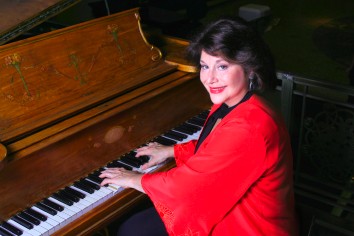 the cocktail hour to hear Daryl Sherman. She has perfect taste in songs, seems to know every good one ever written, plays the piano with a repertoire of satisfying and often surprising chord changes, and sings like an angel. I mentioned the experience in this post early in the life of Rifftides.
the cocktail hour to hear Daryl Sherman. She has perfect taste in songs, seems to know every good one ever written, plays the piano with a repertoire of satisfying and often surprising chord changes, and sings like an angel. I mentioned the experience in this post early in the life of Rifftides.
Well, the rule of all good things has caught up with Daryl and those who became addicted to her at the Waldorf. Stephen Holden broke the news in this morning's New York Times.
As of Sunday evening, those sounds will be stilled. A few weeks ago, Ms. Sherman received word that for economic reasons her tenure at the cocktail terrace between the Empire and Hilton Rooms would end. Saturday and Sunday's performances are four-hour laps, from 3:30 to 7:30 p.m.
Last year, the Hilton hotel chain, which owns the Waldorf-Astoria, was sold to the Blackstone Group of investors. Such sales almost always entail streamlining the operations and cutting back expenses.
To read Holden's entire story, go here.
If other New York hotels aren't beginning vigorous bidding to be Sherman's next stand, they're nuts. Listen to this CD to understand why the Waldorf's self-inflicted loss should be somebody's gain.
While the staff at Rifftides world headquarters labors over outside writing obligations, Washington, DC correspondent John Birchard fills the gap with his impressions of a concert by a major pianist and his new trio.
KENNY BARRON TRIO AT THE KENNEDY CENTER
May 3, 2008
Review by John Birchard
Any lingering suspicion that jazz is a purely American art form could have been wiped
away last night (May 3), as the Kennedy Center for the Performing Arts in Washington, DC, presented the Kenny Barron Trio, made up of Philadelphia's Barron at the piano, Kiyoshi Kitagawa of Osaka, Japan on bass and the drummer Francisco Mela from Bayamo, Cuba. We caught the first of two sets in the Center's Family Theater, an intimate box that features excellent acoustics and steeply-angled seating with good sight lines throughout.
Barron eased into the program with Luis Bonfa's "Manha de Carnaval", first as an unaccompanied solo, then with a comfortable medium bossa nova rhythm. The pianist moved through the changes, making marvelous, unexpected chord
substitutions as he explored the familiar tune. Mela is an interesting drummer. His time is loosey-goosey and he plays around the beat but never loses it.
He has a light but firm touch and uses humor in his fills and solos. Bassist Kitagawa reminds this listener of Charlie Haden in that he usually keeps to the lower register on his instrument, playing firm time with occasional, tasteful decorations inserted in appropriate spots. As for the international aspects of their backgrounds, the two could well have come from Detroit or Central Avenue in L.A. Their playing reveals no "foreign" accents.
The standard "How Deep is the Ocean" followed, taken at a medium tempo. Barron seemed to be thoroughly warmed up, as he spun out a number of finger-busting runs during his solo. The leader introduced each tune with remarks that displayed a warmth and sense of humor, but were not long-winded. Rather like his piano work, his ad libs got straight to the point. An original came next - "Lullaby", a waltz with interesting twists and turns in the melody. Barron followed that with a Monk tune, "Ask me Now" played as a ballad. In so doing, he gave the tune a chance to breathe and he played Monk without trying to sound like Monk. That was refreshing.
In the only "commercial" note of the evening, Barron mentioned that the original titled "Calypso" will be found on his new CD, The Traveler, coming out later this month. This Calypso is one of the few that doesn't sound like "Saint Thomas". It has surprising hesitations built into the melody, but the rhythm is pure infectious Caribbean. Barron exercised his considerable Latin chops on this one.
Inspired by a wedding anniversary visit to Tahiti - the Barrons' 45th, he pointed out - he expressed another attractive original known as "Cook's Bay", with a light Latin beat. The piece has the sort of lilting sound that makes one want to visit that part of the world to see what caused Barron to come up with it. "Cook's Bay" rounded out the set and prompted a loud and long ovation from the sold-out house.
Barron returned to the stage alone and, for an encore, performed the old Eubie Blake-Andy Razaf standard "Memories of You" in what might be described as a delicate stride. It was a captivating performance that demonstrated just how much jazz history Kenny Barron has at his fingertips. He is not an overwhelming player in the manner of Oscar Peterson. But think of all the great players who have hired him over the years and sung his praises, from Dizzy Gillespie to Stan Getz. He is in the middle of the mainstream, but his touch at the keyboard, his rich knowledge of chords, his taste, inventiveness and subtle soul make him, in this listener's book, a national treasure. It was a joy to spend a couple of hours in his company.
Mrs. Rifftides and I spent her birthday far from the madding crowd--and from blogging. We arrived at the Sleeping Lady Mountain Retreat just after a hundred or so conferees had checked out. The sixty-seven enchanted acres on Icicle Creek in the foothills of the
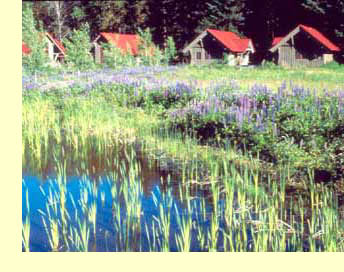 Cascades were almost exclusively ours for a day and night. Winter--several feet of it--was still evident on the peaks above us, but down below we had spring and no obligations.
Cascades were almost exclusively ours for a day and night. Winter--several feet of it--was still evident on the peaks above us, but down below we had spring and no obligations.
We wandered the paths, played horseshoes (badly), climbed the hills among clumps of yellow flowers, briefly tested the elliptical trainer in the exercise room, and had a world-class dinner. The entrée was ono, the fish whose name means "delicious" in Hawaiian, brilliantly prepared by the young chef Rene Nuňez. From our table at the Kingfisher Dining Lodge, we had the unexpected treat of seeing Sleeping Lady's founder and grande dame, Harriet Bullitt, alight from the cable tram that carries her over the creek between her house and the retreat. Later, Mrs. R and I chatted for an hour in the Grotto Bar over a Three Rivers syrah. Back in our room, rustic in its three-star way, we drifted off to sleep to a bullfrog serenade from the pond next door.
There is no television in the rooms at Sleeping Lady. Smoking is not allowed inside or out. Good. Background music at breakfast included recordings by Oscar Peterson, Kenny Burrell and a pretty good trumpet player with a Harmon mute (Sal Marquez?) imitating Miles Davis.
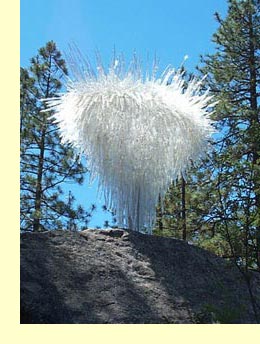 We would rather have done without it. The music intruded on the nature that surrounded us. We were glad to leave it behind, stroll along the creek and see the morning sun illuminate
Dale Chihuly's nine-foot glass sculpture, "Icicle," mounted atop a boulder. One does not need music every hour of the day. I remember once asking Jim Hall, "What are you listening to these days?" "Silence," he said. Bravo. Nearly three years ago, we had a Rifftides discussion about the virtues of silence. To read it, click here.
We would rather have done without it. The music intruded on the nature that surrounded us. We were glad to leave it behind, stroll along the creek and see the morning sun illuminate
Dale Chihuly's nine-foot glass sculpture, "Icicle," mounted atop a boulder. One does not need music every hour of the day. I remember once asking Jim Hall, "What are you listening to these days?" "Silence," he said. Bravo. Nearly three years ago, we had a Rifftides discussion about the virtues of silence. To read it, click here.
Before we crossed the Cascades for home, we shopped amid the kitschy Bavarian charm of the village of Leavenworth. An hour was enough.
Back at my desk, I'm facing deadlines for three pieces of work that, as of today, are officially overdue. That means blogging will have to take a back seat for a while. Until it resumes, please check out the archive. You'll find the link to it in red, in the center column.
Silence is a source of great strength.--Lao Tzu
One of the greatest sounds of them all - and to me it is a sound - is utter, complete silence.--Andre Kostelanetz
Choose silence of all virtues, for by it you hear other men's imperfections, and conceal your own. --George Bernard Shaw
AJ Ads
AJ Blogs
AJBlogCentral | rssculture
Terry Teachout on the arts in New York City
Andrew Taylor on the business of arts & culture
rock culture approximately
Laura Collins-Hughes on arts, culture and coverage
Richard Kessler on arts education
Douglas McLennan's blog
Dalouge Smith advocates for the Arts
Art from the American Outback
Chloe Veltman on how culture will save the world
For immediate release: the arts are marketable
No genre is the new genre
David Jays on theatre and dance
Paul Levy measures the Angles
Judith H. Dobrzynski on Culture
John Rockwell on the arts
innovations and impediments in not-for-profit arts
Jan Herman - arts, media & culture with 'tude
dance
Apollinaire Scherr talks about dance
Tobi Tobias on dance et al...
jazz
Howard Mandel's freelance Urban Improvisation
Focus on New Orleans. Jazz and Other Sounds
Doug Ramsey on Jazz and other matters...
media
Jeff Weinstein's Cultural Mixology
Martha Bayles on Film...
classical music
Fresh ideas on building arts communities
Greg Sandow performs a book-in-progress
Harvey Sachs on music, and various digressions
Bruce Brubaker on all things Piano
Kyle Gann on music after the fact
Greg Sandow on the future of Classical Music
Norman Lebrecht on Shifting Sound Worlds
Joe Horowitz on music
publishing
Jerome Weeks on Books
Scott McLemee on books, ideas & trash-culture ephemera
theatre
Wendy Rosenfield: covering drama, onstage and off
visual
Public Art, Public Space
Regina Hackett takes her Art To Go
John Perreault's art diary
Lee Rosenbaum's Cultural Commentary
